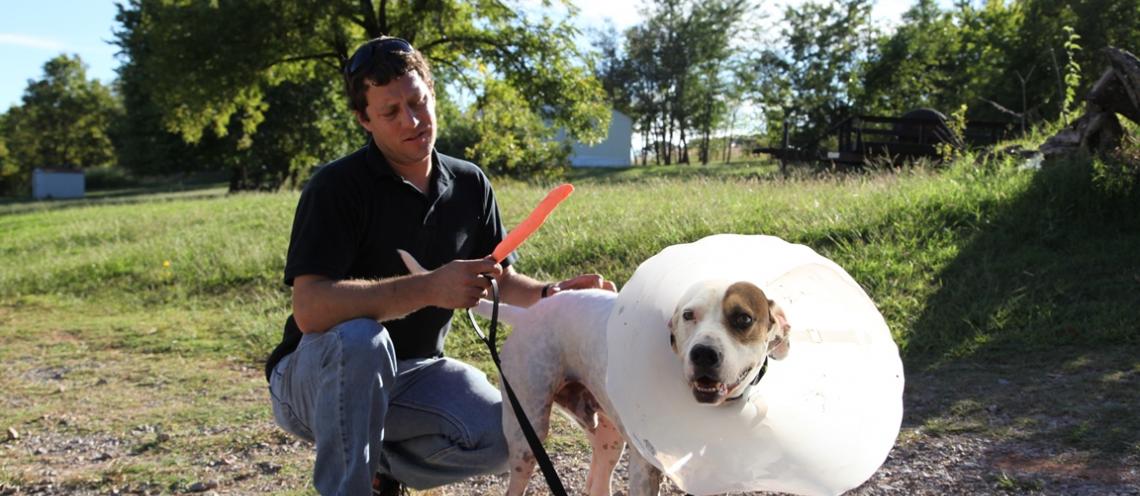
OSU veterinarians treat impaled dog
Monday, September 22, 2014
No one knows how it happened — they can only guess. It’s a miracle he’s alive. It certainly isn’t the type of case that veterinarians at Oklahoma State University’s Veterinary Medical Hospital are used to seeing.
Riley, a 7-year-old pointer/pit bull mix, somehow impaled himself with a stick on Saturday, Sept. 6, 2014.
“Riley is an outside dog. He was a stray that wandered into our yard when he was about 6 months old. I’ve had him ever since. Riley roams free and loves to chase birds and squirrels. He has the muscle build of a pit bull and the habits of a pointer,” said the dog’s owner, Sean Stebler of Perkins, Oklahoma. “While I was away that Saturday afternoon, Riley somehow impaled himself with a stick right under one of his armpits. My cousin lives next door and her dog started barking and went outside. When it came back, Riley was following it with this stick stuck in him and she called to tell me.”
Stebler brought the dog to OSU’s Veterinary Medical Hospital emergency room where Drs. Danielle Dugat and Brandy Cichocki were assigned the case. Dugat is a board-certified small animal surgeon and assistant professor. Cichocki is a first-year small animal surgery resident.
“When Riley arrived he was lying on his side with the stick coming out of the bottom of his chest. Even though we knew it was very painful, Riley was still wagging his tail,” Dugat said. “We gave him pain medication and fluids. We did a physical exam, monitored his blood pressure and electrocardiogram. We ran his bloodwork for anesthesia and took chest X-rays to see if the stick had penetrated the chest cavity.”
Luckily for Riley, chest X-rays helped the veterinarians determine that the stick had not gone into his chest cavity.
“We anesthetized Riley and took him to surgery,” Dugat said. “We cleaned his skin, covered the stick to prevent debris from entering his body and elongated or opened the hole where the stick entered Riley’s body. The stick went in at the bottom of Riley’s chest and moved forward along his chest wall into his armpit. It narrowly missed the nerves that supply his leg.
"Once we removed the stick, Riley was left with tissue that was very irritated and dirty from the stick. We cleaned the area but were not comfortable closing the wound created by the stick. We opted to do bandage management with a drain placed in the wound for the remainder of the week.”
Riley was discharged seven days later. Stebler reports that his dog is doing fine.
“Riley is doing great and wishes he could be outside running,” Stebler said. “He is confined to the house and can only be walked outdoors to go to the bathroom. He needs to be quiet for at least another two weeks to be sure his wound is healed.”
Dugat said Riley is one lucky dog and his prognosis for a full recovery is excellent. And hopefully he won’t "run into" any more sticks.
OSU’s Veterinary Medical Hospital is open to the public for wellness care, specialty referral cases and 24/7 for emergency cases treating all species. For more information, visit vetmed.okstate.edu/ or call 405-744-7000.
